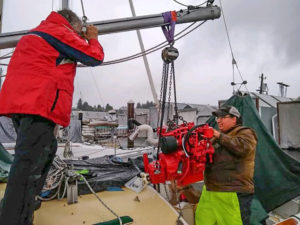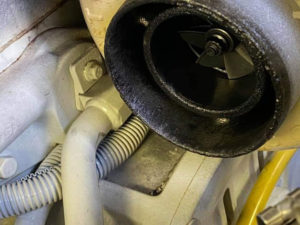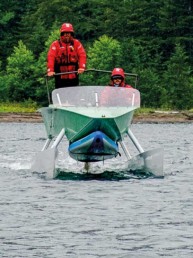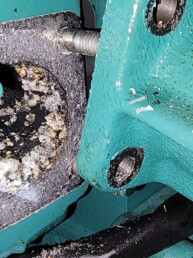This article was originally published in the August 2021 issue of 48° North.
Summer is upon us, and so is boat buying season! For those of us dreaming about a new boat, there can never be enough scouring of boat ads. Hope springs eternal that we can find one within our price range that has all the things we want — more space, good sails, ergonomic layout, and of course some sharp cosmetics. But how many of us really take a close look at what’s lurking underneath the surface of a tantalizing boat prospect?
“But, Meredith — that’s why we hire a surveyor to check out those things?” Did you know that most regular surveys do very little with the engine or electrical? On a boat with a marine inboard diesel, it can be very beneficial to have a mechanical survey done by a certified marine diesel professional to avoid having serious issues with the engine in the future.
These inspections are a part of what I do professionally, and I have been extremely busy with mechanical surveys and inspections throughout the last year of record boat sales. One thing that is too common, in my opinion, is that most people hire me to inspect their engine after they have purchased the boat. And unfortunately, much of the time I am the one giving them the news that the engine isn’t really what they thought it was. This article is going to highlight some of the things I often see when performing mechanical surveys, so you know what to look out for if you are in the process of buying a boat.
 WATCH OUT FOR THE “KRYLON” REBUILD
WATCH OUT FOR THE “KRYLON” REBUILD
Yeah, you read that right. The ad says, “engine was just rebuilt!” Somehow, whenever that is written, I never seem to come across any paperwork or receipts for labor and/or a rebuild kit. Some engines are so old you can’t even buy a rebuild kit anymore. And yet, upon boarding the vessel to take a look, I see a beautiful, thick layer of Krylon spray paint covering the entire engine…even the hoses, clamps, and belts! Nevermind that the engine smokes when running or is hard as hell to start, it has been rebuilt according to the ad.
Be very mindful of a fresh paint job. The manufacturer sometimes paints over hoses and filters and that’s understandable, but the engine better have less than 100 hours on it, since the typical break-in protocol for a new engine requires fluid and filter changes at 10, 25, and 50 hours. If filters are freshly painted and the engine is 30 years old, something is fishy. An older engine should have signs of use and that’s ok. Most smaller engines have V-belts so I expect to see a little belt dust, and maybe some original hoses with cracked paint on them if they are still serviceable. But if filters, belts, injector nuts, and other small things are painted-over, it raises concerns from me that the seller could be trying to hide something.
THE “DIYer” REBUILD
First, let’s acknowledge that diesel work is something everyone can learn. I am always happy to teach students and boat owners of all backgrounds. However, a full rebuild completed by an amateur is a significant and complicated undertaking.
When I put quotes around “DIYer” in this case, it is in reference to a rebuild that is both amateur and incomplete — whether by dubious intent or just inexperience. To me, the “DIYer” rebuild is the type where the auxiliary components on the outside of the engine have been removed, sometimes replaced, cleaned up, and repainted before installing back on the engine with the claim that the engine has been completely overhauled. Sounds crazy, but I’ve seen it before.
While there is nothing wrong with replacing parts that need to be replaced; to me and I imagine most everyone
else, this does not count as an actual teardown and rebuild of an engine. The engine’s main bearings, cylinders, piston rings, and other components still have the same wear on them that they’ve always had — meanwhile, you may think you are getting a newly overhauled engine and will expect it to perform as such.
Whatever the case, you will want to request paperwork to support claims of work done to the engine to verify it has actually been done. Many folks who truly do the work are excited and proud to show you proof of their efforts, and will have complete records of what parts and labor were included.
 THE “SHOP” REBUILD
THE “SHOP” REBUILD
Well, this can be a wonderful thing or a terrible thing. If the engine was removed from the boat and professionally rebuilt by a certified engine shop, then you are in luck — the work was most likely done properly and may even come with a warranty. If you see paperwork proving this, and the engine appears to be in good shape and runs well with support from a good oil sample, then go for it!
The issues I see are often when an engine has been rebuilt by a boatyard or independent contractor who isn’t qualified or experienced enough to be getting into an engine. Several times, I’ve seen an engine that was “professionally” rebuilt, but the job was done so poorly that I had to come in multiple times for serious repairs that shouldn’t have been necessary if the rebuild was completed by a true professional.
Keep in mind, this also could be the reason the boat is for sale. A lot of times, the engine will look great on the outside, but there may be hints that something is not right – maybe a noise, some smoke, difficulty starting, etc. Be very wary of this if you have questions about the shop or individual that performed the work.
Your initial inspection is critical to assessing the engine for yourself. Hiring a marine mechanical surveyor and taking fluid samples prior to making an offer can really pay off in the long run. If you are confident with engines, then maybe buying a cheaper boat with an engine that needs your love might be the path to take. The key is to be aware of everything you may need to do, and to be willing to work with it or negotiate to have the problem fixed properly prior to the sale.
Marine engines are extremely expensive to have rebuilt or replaced, so it’s not something you should take lightly. If the ad says “rebuilt”, take the time to confirm it, and you may have found a gem. If you keep these tips in mind, finding a boat with a decent engine will be much easier, and this will allow you to have more fun out on the water.
A FEW TIPS TO SET YOU ON YOUR WAY
If you look closely, the engine can give you clues that it may be more of a project then you were expecting to take on:
1) Look for signs of recent maintenance. Fresh filters, new hoses and clamps, clean engine, and clean engine compartment can tell you that the owner of the boat really cares about his/her engine. A clean engine and compartment indicates the owner was most likely meticulous with maintenance.
2) Look for signs of neglect. Check belts, hoses, thru-hull, heat exchanger, etc. Hoses that appear original and are terribly aged are a sign that the owner may not have paid much attention to the engine, let alone maintained it. Rusty coolant or low fluids can also be a sign of neglect.
3) Research the engine make and model and whether you can still get parts for it. Many recreational boats have engines that are obsolete, making it extremely difficult to get even basic parts, as the companies that marinized them have long since gone out of business or are done producing parts. Pisces engines (marinized Nissan forklift engines) are an example of an engine for which you may not even be able to find a fuel filter on certain models – don’t ask me how I know this…
4) Put your hand on the engine prior to hearing it start for the first time. An engine is typically harder to start when cold, but will start more easily once warm. So, if the engine is warm prior to your arrival or is already running, the owner is probably trying to make it appear easy to start. Ask the seller to show you a true cold start.
5) Look, listen, and feel for anything that may not be normal. Watch for smoke at startup and during operation regardless of the appearance of the engine, listen for noises coming from inside the engine, and pay attention to it while it runs. Open the oil cap and feel for blowby (exhaust getting past the piston rings… not good) for a quick and easy idea of how worn an engine really
is. Look for oil dripping out of the air cleaner or a saturated air cleaner.






